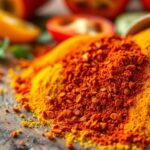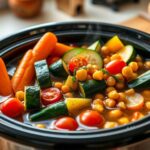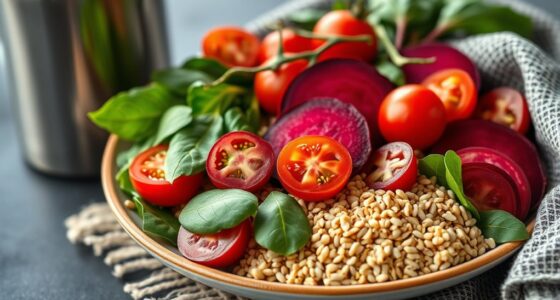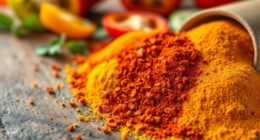Spicy vegetarian cuisine from around the world features bold flavors, vibrant spices, and regional ingredients that prove plant-based dishes can be fiery and satisfying. From fiery Indian curries and creamy Middle Eastern eggplant stews to smoky Latin American stuffed peppers and flavorful falafel wraps, these dishes showcase how spices like chili, cumin, and harissa elevate simple vegetables and legumes. If you want to explore more about these spicy vegetarian favorites, you’ll discover exciting culinary traditions from every corner of the globe.
Key Takeaways
- Diverse global cuisines feature bold, spicy vegetarian dishes, including Indian curries, Middle Eastern stews, and Latin American stuffed peppers.
- Spices like chili, cumin, turmeric, and harissa are used worldwide to enhance flavor and heat in vegetarian recipes.
- Meat substitutes such as paneer, tofu, and plant-based chorizo absorb spices, creating satisfying, fiery vegetarian meals.
- Regional dishes emphasize complex spice combinations, balancing heat, aroma, and texture to elevate vegetarian ingredients.
- Growing global interest in plant-based diets encourages culinary creativity, blending spices and ingredients for bold vegetarian flavors.
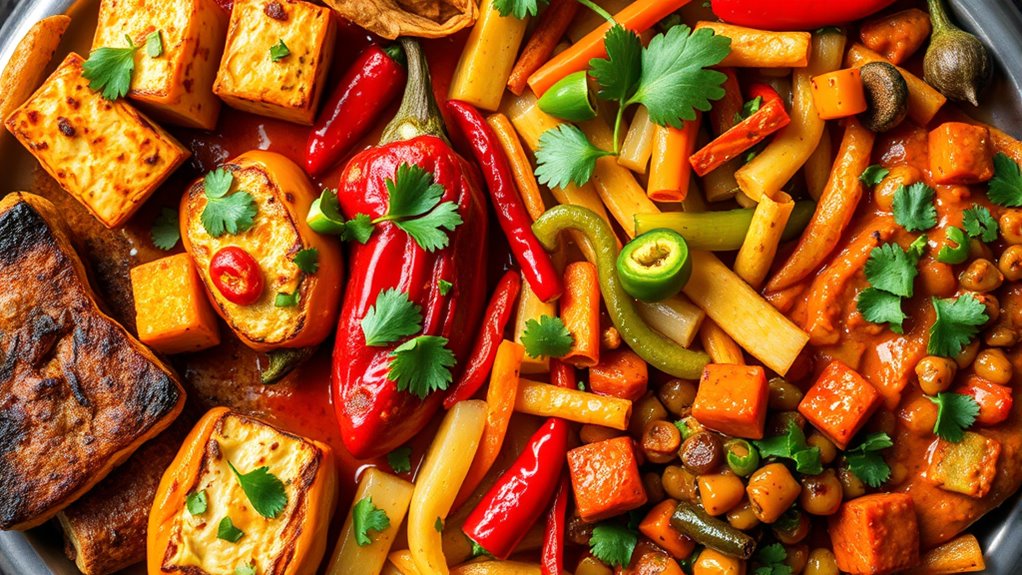
Have you ever wondered how diverse and flavorful vegetarian dishes can be across different cultures? The world offers an incredible variety of spicy vegetarian cuisine that showcases the creativity and bold flavors found in many culinary traditions. Whether you’re a spice enthusiast or just curious about exploring new tastes, you’ll find that vegetarian dishes often feature innovative meat substitutes and vibrant spice levels that pack a punch. These dishes prove that going plant-based doesn’t mean sacrificing flavor or excitement on your plate.
Discover how vibrant spices and clever substitutes make vegetarian cuisine exciting worldwide.
In many Asian countries, especially India, spicy vegetarian dishes are staples. Think of fiery curries loaded with vegetables and lentils, seasoned with an array of spices like chili, cumin, coriander, and turmeric. Instead of meat, these recipes rely heavily on meat substitutes such as paneer, tofu, or textured vegetable protein that absorb flavors beautifully. The spice levels can vary from mild to extremely hot, depending on regional preferences and individual taste. The use of spices isn’t just about heat; it’s about creating complex layers of flavor that elevate simple ingredients into something extraordinary. You’ll notice that the balance of heat, aroma, and texture makes these dishes addictive and deeply satisfying.
Moving to the Middle East, you’ll encounter dishes like spicy falafel wraps or eggplant stews that are rich in bold spices. Here, spice levels tend to be robust, often incorporating harissa or chili paste to add heat. Meat substitutes like chickpeas or eggplants serve as central ingredients, offering hearty textures and absorbing spices well. The use of fresh herbs and spices amplifies the flavor profile, making each bite vibrant and memorable. These dishes often emphasize a harmony of heat and aroma, giving you a complex sensory experience that’s both comforting and exciting.
In Latin America, vegetarian dishes such as spicy stuffed peppers or bean-based stews highlight the region’s love for fiery flavors. The spice levels are usually quite high, complemented by ingredients like chili peppers, cumin, and oregano. Meat substitutes, such as plant-based chorizo or soy-based fillings, help mimic the textures and flavors of traditional meat-based dishes. These dishes often blend heat with smoky undertones, creating a rich, satisfying experience that showcases the region’s culinary boldness.
Across these diverse cuisines, one thing remains clear: spicy vegetarian dishes leverage the power of spices and meat substitutes to create exciting, flavorful meals. They demonstrate that vegetarian food can be just as bold and fiery as its meat-based counterparts. The increasing popularity of plant-based diets has led chefs worldwide to experiment with bold flavors and spice combinations to satisfy both vegetarians and spice lovers alike. So, whether you’re craving a fiery Indian curry, a spicy Middle Eastern stew, or a Latin American pepper stuffed with flavorful fillings, you’ll find that the world’s spicy vegetarian cuisine offers endless possibilities to satisfy your taste buds.
Frequently Asked Questions
Which Spices Are Most Common in Global Vegetarian Dishes?
You’ll find cumin, coriander, and turmeric are the most common spices in global vegetarian dishes. These spices create rich flavor combinations that enhance the taste and offer depth. You’ll also notice chili peppers and ginger for heat, balanced with spices like cinnamon or cardamom for flavor balancing. Using these spices thoughtfully brings out vibrant, authentic flavors in vegetarian cuisine, making each dish exciting and satisfying.
How Can I Make Vegetarian Dishes Less Spicy if Needed?
Think of this as your culinary time machine, where you can switch from fiery to mild. To diminish spiciness, use spice reduction techniques like adding dairy, vinegar, or sugar, which neutralize heat. For mild flavor enhancement, incorporate ingredients like coconut milk or tomato sauce. These methods help you tailor dishes to your preference and guarantee everyone enjoys your vegetarian creations without the fiery kick.
Are There Traditional Vegetarian Spicy Recipes From Specific Regions?
Yes, you’ll find plenty of traditional vegetarian spicy recipes from various regions. For example, you might enjoy Indian vegetarian street food like spicy chana masala or South Korean spicy vegan stews. These dishes often feature bold flavors and fiery spices. If you prefer less heat, you can always adjust the spice levels. Exploring these recipes allows you to experience authentic, flavorful vegetarian cuisine from around the world.
What Are the Health Benefits of Spicy Vegetarian Foods?
Imagine your body as a garden, thriving with the right nutrients. Spicy vegetarian foods boost your health by providing antioxidant properties that fight free radicals, helping you stay energized. They also support digestive health, reducing bloating and discomfort. For example, adding chili peppers to your meals can enhance metabolism and promote gut wellness, making your body a resilient, flourishing garden. Embrace these foods for a tasty, health-boosting routine.
How Do Different Cultures Balance Heat and Flavor in Vegetarian Cuisine?
You can balance heat and flavor in vegetarian cuisine by using fusion techniques that blend diverse spice profiles, creating harmony rather than overwhelming heat. Cultures prioritize flavor hierarchies, ensuring spices enhance rather than overpower ingredients. For example, in Indian dishes, spices like cumin and coriander complement chili’s heat, while Thai cuisine balances fiery chilies with sweet and sour elements. Experimenting with these approaches helps you craft flavorful, well-balanced vegetarian dishes.
Conclusion
As you explore spicy vegetarian dishes from around the world, you’ll see how vibrant flavors unite diverse cultures. Did you know that plant-based diets now account for nearly 40% of global food consumption? This shift highlights a growing appreciation for sustainable, flavorful vegetarian cuisine. Embrace these fiery, healthy options in your own cooking, and join a global movement toward more mindful, spicy eating. Your taste buds—and the planet—will thank you.
Ilana has been a vegan for over 10 years. She originally made the switch for health reasons, but soon found herself becoming more and more passionate about the ethical and environmental implications of a vegan lifestyle. Ilana is the author of The Graceful Kitchen, a blog all about veganism. She loves to cook up delicious and nutritious vegan meals, and share her recipes with others who are interested in leading a cruelty-free life. Ilana is also a strong advocate for using whole foods as the foundation of a healthy diet, and believes that going vegan is one of the best ways to achieve this.


